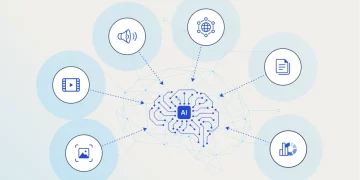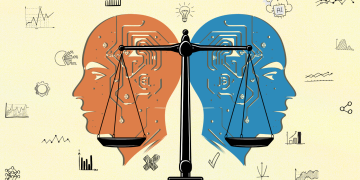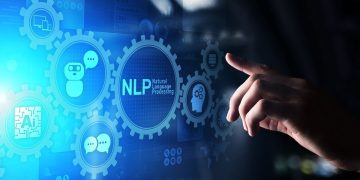Introduction:
In today’s fast-paced, data-driven world, the combination of Artificial Intelligence (AI) and Big Data is creating vast opportunities for businesses to optimize their operations, enhance decision-making, and ultimately gain a competitive advantage. AI, with its ability to simulate human intelligence, and Big Data, which refers to the massive volumes of data generated daily, are revolutionizing industries across the board.
Enterprises that effectively combine these technologies are able to make sense of complex data, uncover valuable insights, improve customer experiences, streamline operations, and make more informed strategic decisions. However, leveraging AI and Big Data successfully requires not only the right technology and infrastructure but also a clear strategy and a deep understanding of how to apply these technologies to specific business needs.
This article explores how businesses can harness the power of AI and Big Data to enhance their competitive edge, the challenges they may face, and the strategies they can adopt to fully realize the potential of these technologies.
1. The Convergence of AI and Big Data: A Powerful Combination
Before diving into how enterprises can leverage AI and Big Data, it is essential to understand how these technologies complement each other and why their convergence is so powerful.
1.1. Big Data: Unlocking Valuable Insights
Big Data refers to the vast amounts of structured and unstructured data generated by various sources—social media, transaction logs, IoT devices, sensors, customer interactions, and more. It is characterized by the “three Vs”:
- Volume: Massive amounts of data created every second.
- Velocity: The speed at which data is generated and processed.
- Variety: The different types and formats of data (structured, semi-structured, unstructured).
Big Data analytics allow businesses to process and analyze this data to uncover patterns, trends, and correlations that would otherwise be difficult to identify. By leveraging Big Data, organizations can gain insights into consumer behavior, market trends, operational inefficiencies, and other critical factors that influence their business success.
1.2. Artificial Intelligence: Automating Insights and Decision-Making
Artificial Intelligence, particularly Machine Learning (ML) and Deep Learning, is the ability of machines to simulate human cognitive functions like learning, problem-solving, and decision-making. AI algorithms can process vast datasets at scale, find hidden patterns, and generate predictive insights.
When combined with Big Data, AI can automate the extraction of actionable insights, optimize processes, and enable data-driven decision-making. Machine learning models, for instance, can predict customer preferences, identify potential risks, and recommend the best actions to take based on historical data and real-time information.
The integration of AI and Big Data is creating a feedback loop where the insights generated by Big Data fuel AI algorithms, which, in turn, refine their models and improve their predictions. This synergy leads to smarter business strategies, enhanced operational efficiency, and an improved customer experience.
2. How Enterprises Can Leverage AI and Big Data to Gain a Competitive Advantage
Now that we understand the synergy between AI and Big Data, let’s explore specific ways in which enterprises can harness these technologies to enhance their competitive edge.
2.1. Improved Decision-Making with Data-Driven Insights
One of the most significant benefits of combining AI and Big Data is the ability to make data-driven decisions. In the past, decision-making in many organizations was based on intuition, experience, or outdated information. Today, AI and Big Data allow businesses to make real-time, data-backed decisions that drive growth and performance.
- Predictive Analytics: AI algorithms can analyze historical and real-time data to forecast trends and outcomes. For instance, AI-powered predictive analytics can help businesses forecast demand, optimize inventory levels, and manage resources more effectively. This level of insight allows businesses to proactively respond to market changes, rather than reacting to them.
- Advanced Business Intelligence (BI): Big Data combined with AI-powered BI tools can provide executives and decision-makers with sophisticated dashboards, reports, and visualizations. These insights can help identify emerging market opportunities, customer needs, and potential threats, enabling businesses to make smarter, faster decisions.
2.2. Enhanced Customer Experience
Customer expectations are rising, and delivering an exceptional customer experience (CX) is crucial to staying competitive in today’s market. AI and Big Data can transform how companies engage with customers and personalize their offerings.
- Personalization: By analyzing vast amounts of customer data, AI models can predict customer preferences, behaviors, and needs. Businesses can use this information to offer personalized recommendations, targeted advertisements, and custom-tailored services. For example, Netflix and Amazon leverage AI and Big Data to suggest movies, TV shows, or products based on a user’s browsing and purchase history, enhancing customer satisfaction and engagement.
- Chatbots and Virtual Assistants: AI-powered chatbots and virtual assistants enable businesses to provide 24/7 customer support and handle inquiries at scale. By integrating these AI systems with customer data, businesses can provide more accurate and contextually relevant responses, improving the overall customer experience.
- Sentiment Analysis: By analyzing customer feedback, reviews, and social media posts, AI can gauge customer sentiment and provide valuable insights into brand perception. Companies can use this information to fine-tune their messaging, resolve issues promptly, and improve their products or services.
2.3. Optimized Operations and Cost Efficiency
AI and Big Data can significantly improve operational efficiency, reduce costs, and streamline processes. By leveraging AI’s ability to analyze data in real-time, businesses can optimize various aspects of their operations.
- Supply Chain Optimization: Big Data can track and monitor supply chains in real-time, while AI can predict potential disruptions (such as supply shortages or transportation delays) and recommend the best course of action. This enables companies to make data-driven decisions that minimize delays, reduce costs, and ensure the efficient flow of goods.
- Predictive Maintenance: In industries like manufacturing and energy, AI and Big Data can predict when machinery or equipment is likely to fail. By using data from sensors and IoT devices, AI models can detect early signs of malfunction, allowing businesses to perform maintenance proactively rather than reactively. This can prevent costly downtime, extend the lifespan of equipment, and reduce repair costs.
- Process Automation: AI can automate repetitive and time-consuming tasks, such as data entry, report generation, and customer inquiries, freeing up employees to focus on more strategic initiatives. By automating business processes, organizations can reduce human error, improve accuracy, and lower operational costs.
2.4. Innovation and Product Development
In a competitive market, innovation is essential for growth and differentiation. AI and Big Data are helping companies accelerate research and development (R&D) efforts and bring innovative products to market faster.
- Market Research: Big Data allows businesses to analyze consumer behavior, market trends, and competitor activities. AI can then help identify new opportunities for product development or improvements to existing products. For example, companies can track customer reviews, social media conversations, and purchase behavior to understand market demand and identify gaps in the market.
- Product Customization: AI and Big Data enable businesses to develop products and services that are more tailored to individual customer needs. For example, in the fashion industry, AI can analyze customer preferences and purchasing patterns to create personalized designs or collections, while in software development, data can inform the creation of features that address specific user pain points.
2.5. Risk Management and Fraud Detection
AI and Big Data are also playing a crucial role in managing risk and detecting fraudulent activities across various industries.
- Fraud Detection: AI-powered algorithms can analyze transaction data and identify unusual patterns that might indicate fraudulent activity. Banks and financial institutions, for example, use AI to monitor transactions in real time and flag any suspicious behavior. By leveraging Big Data, AI can detect fraud more accurately and quickly than traditional methods.
- Risk Assessment: AI models can assess business risks by analyzing historical data and predicting potential threats. This allows companies to take preemptive measures to mitigate risks, whether they relate to financial, operational, or market factors. In insurance, for instance, AI can analyze customer data to assess the likelihood of claims and help set optimal pricing strategies.

3. Challenges in Leveraging AI and Big Data
While the potential benefits of AI and Big Data are vast, enterprises also face several challenges in effectively leveraging these technologies.
3.1. Data Quality and Integration
Big Data is only valuable if it is accurate, clean, and integrated. Enterprises often struggle with data silos, where data is stored in different systems or departments and is not easily accessible or integrated. Ensuring data quality and seamless integration across various platforms is a critical step for successfully using AI and Big Data.
3.2. Talent and Expertise
Implementing AI and Big Data solutions requires skilled data scientists, engineers, and AI specialists. Finding and retaining talent with the necessary expertise can be challenging, particularly for smaller companies with limited resources.
3.3. Privacy and Security Concerns
With the rise of data-driven technologies, concerns about data privacy and security are growing. Businesses must ensure they comply with data protection regulations (such as GDPR) and implement robust cybersecurity measures to protect sensitive data from breaches.
4. Conclusion: Harnessing the Power of AI and Big Data for Competitive Advantage
The combination of Artificial Intelligence and Big Data is a game-changer for businesses seeking to enhance their competitive edge. By leveraging these technologies, enterprises can gain valuable insights, improve operational efficiency, deliver superior customer experiences, and drive innovation.
However, successfully harnessing the power of AI and Big Data requires a strategic approach, investment in the right infrastructure, and a commitment to overcoming challenges such as data quality, talent acquisition, and privacy concerns. As these technologies continue to evolve, businesses that effectively integrate AI and Big Data into their operations will be well-positioned to stay ahead of the competition and thrive in an increasingly data-driven world.











































